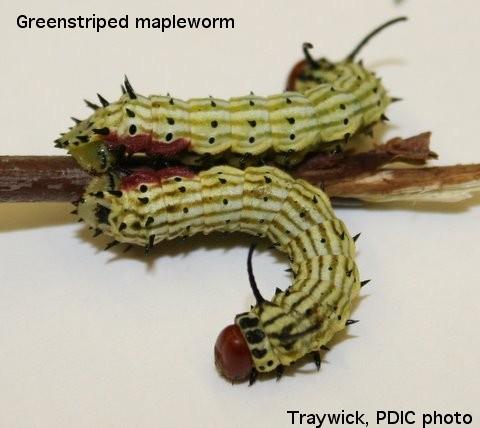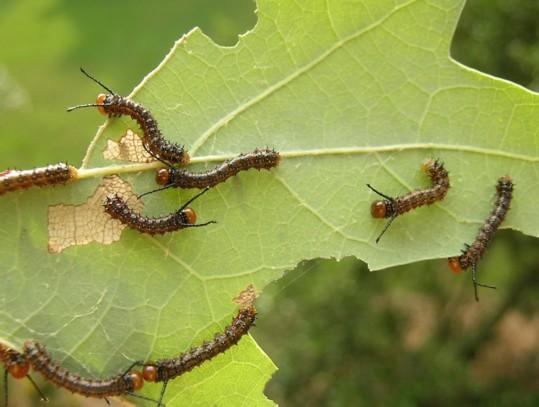General Information
There are more than 1,400 kinds of moths and butterflies in North Carolina. Some of these lay eggs from which hatch destructive caterpillars that feed on our trees and shrubs.
The moths and butterflies (adults) cannot do any damage to plants themselves. The following caterpillars are commonly reported from ornamental plants. Not all occur in high numbers to be considered pests. Learn more about the species of your interest before applying pesticides.
- Bagworm - mostly evergreen
- Birch skeletonizer - birch
- Cankerworm - elm, maple, oak, etc.
- Catalpa sphinx - catalpa
- Cecropia moth - many trees
- Eastern tent caterpillar - cherry, apple
- Fall webworm - pecan, sourwood, persimmon,etc.
- Forest tent caterpillar - maple, oak, poplar
- Giant Swallowtail (Figure 1) - Hercules club, prickley ash, citrus
- Greenstriped mapleworm (Figure 2) - maple, oak, etc.
- Hemlock looper - hemlock
- Hickory horned devil (Regal Moth) - hickory, walnut and others
- Imperial moth - many trees
- Io moth - various trees and shrubs
- Juniper webworm - junipers
- Luna moth - many forest & shade trees
- Pinkstriped oakworm - oak
- Polyphemus moth - many trees
- Poplar tentmaker - poplar, willow
- Promethea moth - many trees
- Redhumped caterpillar - cherry, dogwood
- Redhumped oakworm - oak, elm, etc.
- Saddled prominent - maple, beech, etc.
- Spiny oakworm - oak
- Stinging caterpillars - oak, many others
- Uglynest caterpillar - cherry, etc.
- Walnut caterpillar - pecan, walnut, etc.
- Yellownecked caterpillar - hickory, oak
Sawflies in the larval stage look very much like moth caterpillars. They may cause severe defoliation. Sawflies belong in the group of insects which includes ants, bees, and wasps.
- Dusky birch sawfly (Figure 5) - birch
- Elm sawfly - elm
- Pin oak sawfly - oak
- Redheaded pine sawfly
Control
The single attack of a leaf-feeding insect will seldom kill a healthy tree or shrub. Repeated defoliations, however, may weaken and make them susceptible to destruction by other insects, diseases, severe cold weather, drought, etc. Most of those listed above are not a serious threat.
Try to identify the specific insect before taking control measures. Your local Cooperative Extension center can help. Further information about some of the more serious caterpillar pests is contained in other specific insect pest notes.
Some pesticides are labeled for "caterpillars." Other pesticides may be labeled for certain types of caterpillars such as armyworms, bagworms, cankerworms, webworms. Some pesticides are even labeled for specific caterpillars such as yellownecked caterpillars or eastern tent caterpillars. A complete list of all such pesticides and all of their target pests is too long for this insect note. The Southeastern US Pest Control Guide for Nursery Crops and Landscape Plantings has a more complete list of pesticides and target pests. Bacterial insecticides such as Bacillus thuringiensis (B.t.) are useful only when caterpillars are small.
Other Resources
- Bagworms in Ornamental Landscapes. Frank, S. and J. Baker. 2019 (revised). NC State Extension Publications Insect Notes.
- Cecropia Moth. Baker, J. 2019 (revised). NC State Extension Publications PDIC Factsheets.
- Eastern Tent Caterpillar. Frank, S. and J. Baker. 2019 (revised). NC State Extension Publications Insect Notes.
- Fall Cankerworm. Frank, S. et al. 2019 (revised). NC State Extension Publications Insect Notes.
- Fall Webworm. Frank, S. et al. 2019 (revised). NC State Extension Publications Insect Notes.
- Forest Tent Caterpillar. Baker, J. 2019 (revised). NC State Extension Publications PDIC Factsheets.
- Greenstriped Mapleworm. Frank, S. and A. Dale. 2019 (revised). NC State Extension Publications Insect Notes.
- Hickory Horned Devil \ Regal Moth. Baker, J. 2019 (revised). NC State Extension Publications PDIC Factsheets.
- Imperial Moth. Baker, J. 2019 (revised). NC State Extension Publications PDIC Factsheets.
- Juniper Webworm. Frank, S. and J. Baker. 2019 (revised). NC State Extension Publications Insect Notes.
- Poplar Tentmaker. Baker, J. 2019 (revised). NC State Extension Publications PDIC Factsheets.
- Redheaded Pine Sawfly. Baker, J. 2019 (revised). NC State Extension Publications PDIC Factsheets
- Spring Cankerworm. Frank, S. and J. Baker. 2019 (revised). NC State Extension Publications PDIC Factsheets.
- Walnut Caterpillar. Baker, J. 2019 (revised). NC State Extension Publications PDIC Factsheets.
- Whitemarked tussock moth. Baker, J. 2019 (revised). NC State Extension Publications PDIC Factsheets.
- Yellownecked Caterpillar in the Landscape. Baker, J. 2019 (revised). NC State Extension Publications PDIC Factsheets.
For assistance with a specific problem, contact your local Cooperative Extension center.
Publication date: July 1, 2009
N.C. Cooperative Extension prohibits discrimination and harassment regardless of age, color, disability, family and marital status, gender identity, national origin, political beliefs, race, religion, sex (including pregnancy), sexual orientation and veteran status.





